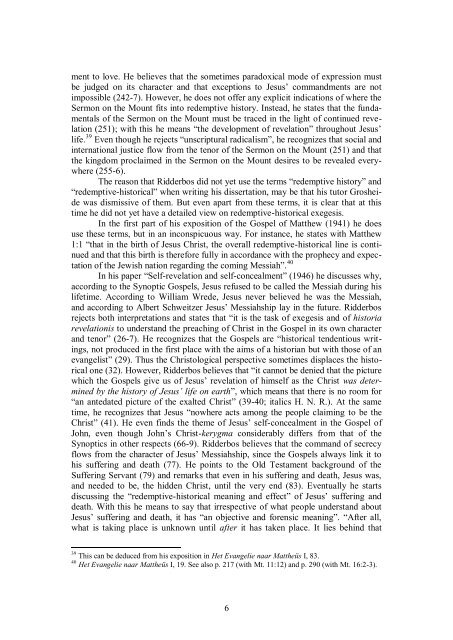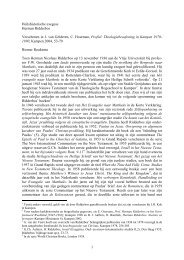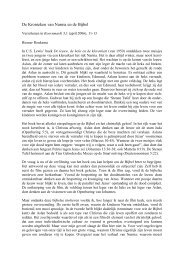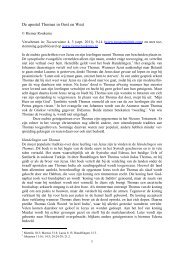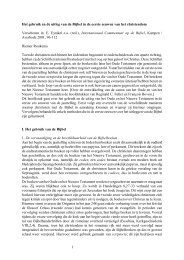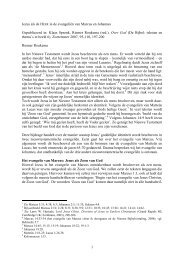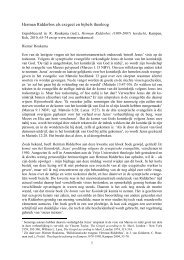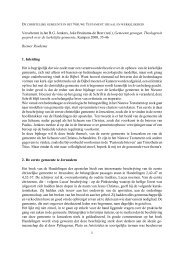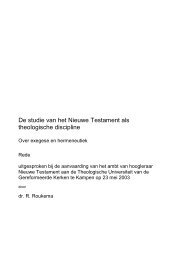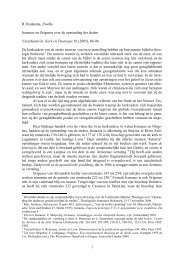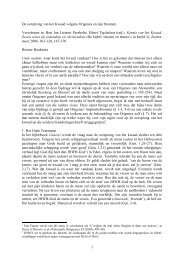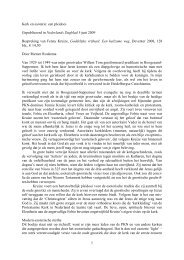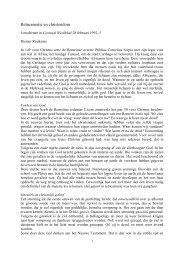Herman Ridderbos‟s Redemptive -historical ... - Riemer Roukema
Herman Ridderbos‟s Redemptive -historical ... - Riemer Roukema
Herman Ridderbos‟s Redemptive -historical ... - Riemer Roukema
You also want an ePaper? Increase the reach of your titles
YUMPU automatically turns print PDFs into web optimized ePapers that Google loves.
ment to love. He believes that the sometimes paradoxical mode of expression must<br />
be judged on its character and that exceptions to Jesus‟ commandments are not<br />
impossible (242-7). However, he does not offer any explicit indications of where the<br />
Sermon on the Mount fits into redemptive history. Instead, he states that the fundamentals<br />
of the Sermon on the Mount must be traced in the light of continued revelation<br />
(251); with this he means “the development of revelation” throughout Jesus‟<br />
life. 39 Even though he rejects “unscriptural radicalism”, he recognizes that social and<br />
international justice flow from the tenor of the Sermon on the Mount (251) and that<br />
the kingdom proclaimed in the Sermon on the Mount desires to be revealed everywhere<br />
(255-6).<br />
The reason that Ridderbos did not yet use the terms “redemptive history” and<br />
“redemptive-<strong>historical</strong>” when writing his dissertation, may be that his tutor Grosheide<br />
was dismissive of them. But even apart from these terms, it is clear that at this<br />
time he did not yet have a detailed view on redemptive-<strong>historical</strong> exegesis.<br />
In the first part of his exposition of the Gospel of Matthew (1941) he does<br />
use these terms, but in an inconspicuous way. For instance, he states with Matthew<br />
1:1 “that in the birth of Jesus Christ, the overall redemptive-<strong>historical</strong> line is continued<br />
and that this birth is therefore fully in accordance with the prophecy and expectation<br />
of the Jewish nation regarding the coming Messiah”. 40<br />
In his paper “Self-revelation and self-concealment” (1946) he discusses why,<br />
according to the Synoptic Gospels, Jesus refused to be called the Messiah during his<br />
lifetime. According to William Wrede, Jesus never believed he was the Messiah,<br />
and according to Albert Schweitzer Jesus‟ Messiahship lay in the future. Ridderbos<br />
rejects both interpretations and states that “it is the task of exegesis and of historia<br />
revelationis to understand the preaching of Christ in the Gospel in its own character<br />
and tenor” (26-7). He recognizes that the Gospels are “<strong>historical</strong> tendentious writings,<br />
not produced in the first place with the aims of a historian but with those of an<br />
evangelist” (29). Thus the Christological perspective sometimes displaces the <strong>historical</strong><br />
one (32). However, Ridderbos believes that “it cannot be denied that the picture<br />
which the Gospels give us of Jesus‟ revelation of himself as the Christ was determined<br />
by the history of Jesus’ life on earth”, which means that there is no room for<br />
“an antedated picture of the exalted Christ” (39-40; italics H. N. R.). At the same<br />
time, he recognizes that Jesus “nowhere acts among the people claiming to be the<br />
Christ” (41). He even finds the theme of Jesus‟ self-concealment in the Gospel of<br />
John, even though John‟s Christ-kerygma considerably differs from that of the<br />
Synoptics in other respects (66-9). Ridderbos believes that the command of secrecy<br />
flows from the character of Jesus‟ Messiahship, since the Gospels always link it to<br />
his suffering and death (77). He points to the Old Testament background of the<br />
Suffering Servant (79) and remarks that even in his suffering and death, Jesus was,<br />
and needed to be, the hidden Christ, until the very end (83). Eventually he starts<br />
discussing the “redemptive-<strong>historical</strong> meaning and effect” of Jesus‟ suffering and<br />
death. With this he means to say that irrespective of what people understand about<br />
Jesus‟ suffering and death, it has “an objective and forensic meaning”. “After all,<br />
what is taking place is unknown until after it has taken place. It lies behind that<br />
39 This can be deduced from his exposition in Het Evangelie naar Mattheüs I, 83.<br />
40 Het Evangelie naar Mattheüs I, 19. See also p. 217 (with Mt. 11:12) and p. 290 (with Mt. 16:2-3).<br />
6


